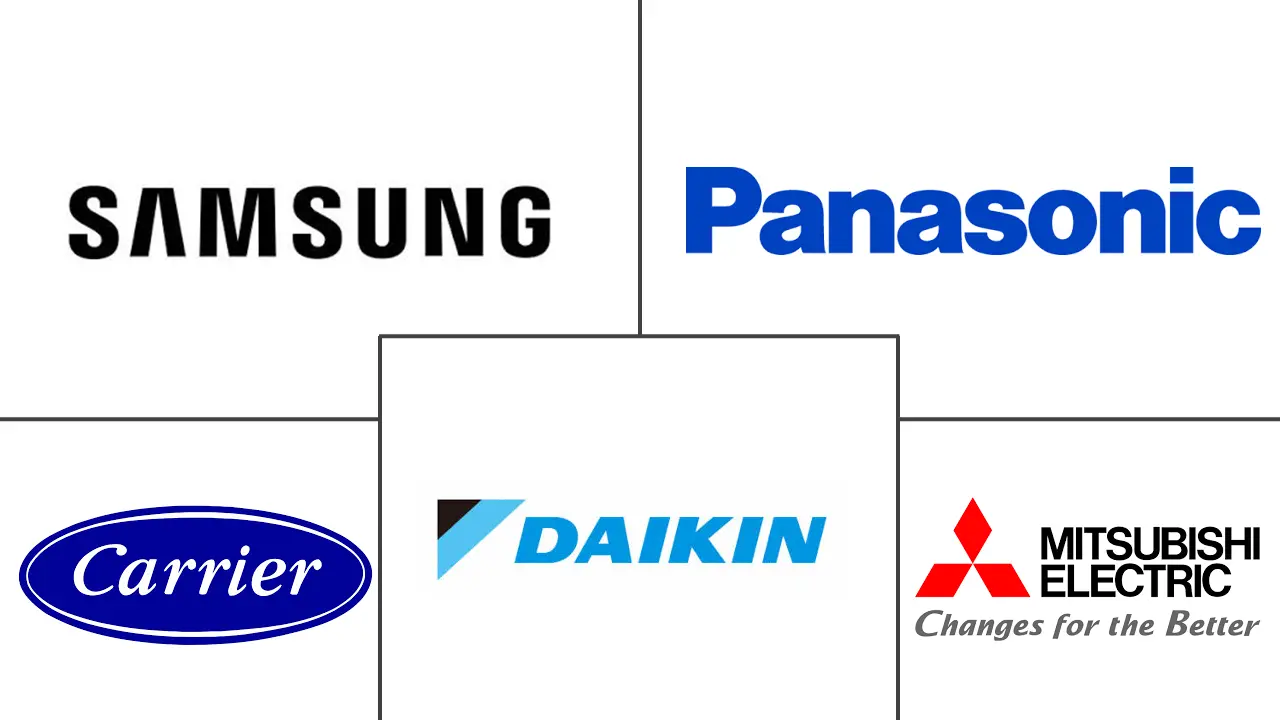Split Air Conditioner Systems Market Size and Share
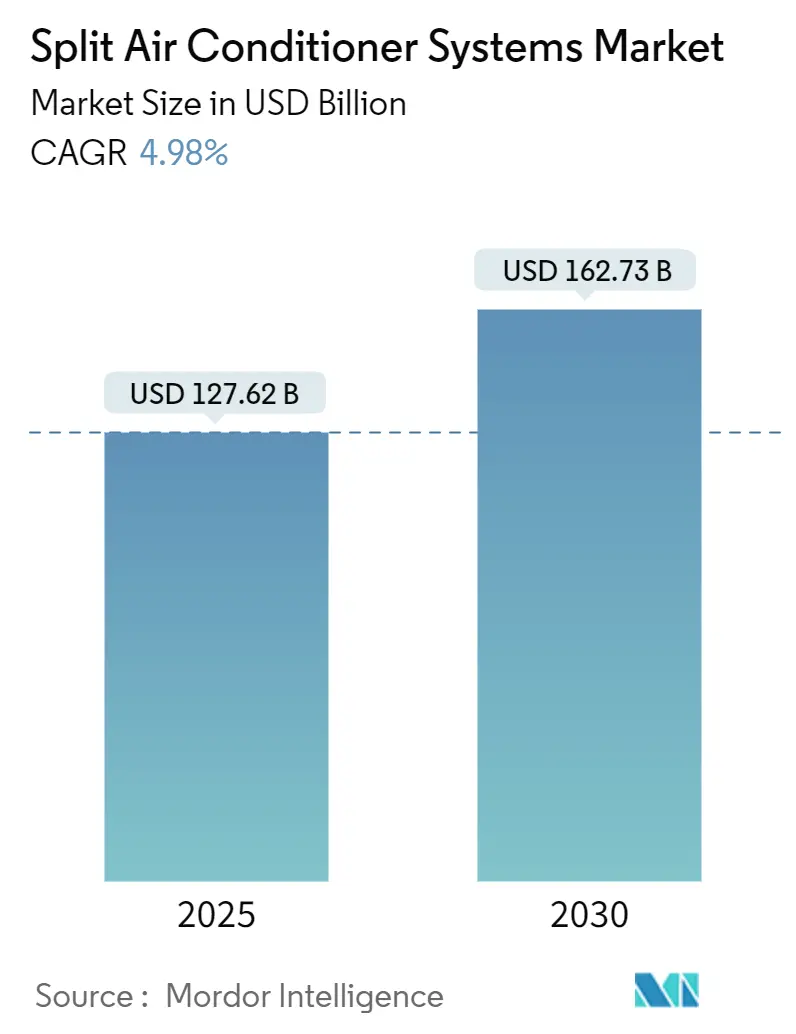
Split Air Conditioner Systems Market Analysis by Mordor Intelligence
The split air conditioner systems market size stands at USD 127.62 billion in 2025 and is forecast to reach USD 162.73 billion by 2030, reflecting a 4.98% CAGR over the period. Strong retrofit demand, tightening energy-efficiency rules, and a decisive pivot toward commercial installations keep growth on track despite supply chain volatility. Variable Refrigerant Flow (VRF) systems gain ground in offices and hospitality properties because they heat and cool simultaneously, while inverter technology captures incremental demand by slashing electricity use up to 50%. E-commerce channels add pricing transparency and widen access to financing, prompting traditional retailers to expand installation services. Rising disposable income in emerging economies, combined with climate-change-induced heat waves, lengthens cooling seasons and heightens the urgency of efficient units. Finally, manufacturer investment in low-GWP refrigerants shields margins and opens green-building revenue streams.
Key Report Takeaways
- By equipment type, mini-split units led with 46.73% of the split air conditioner systems market share in 2024, while VRF systems are projected to expand at a 6.13% CAGR through 2030.
- By application, residential installations accounted for 62.49% of the split air conditioner systems market size in 2024, whereas the commercial segment is advancing at a 6.87% CAGR to 2030.
- By cooling capacity, less than or equal to 12,000 (1-Ton) BTU units commanded 36.77% of the split air conditioner systems market size in 2024, yet units ≥36,000 BTU are growing fastest at a 6.22% CAGR through 2030.
- By technology, inverter models captured 71.32% of the split air conditioner systems market share in 2024 and are set to rise at a 6.93% CAGR to 2030.
- By distribution channel, multi-brand retail retained 69.86% of the split air conditioner systems market size in 2024, although e-commerce sales are climbing at a 6.46% CAGR to 2030.
- By geography, Asia-Pacific generated 41.53% of 2024 revenue, whereas South America is on course for the fastest 5.64% CAGR through 2030.
Global Split Air Conditioner Systems Market Trends and Insights
Drivers Impact Analysis
| Driver | (~) % Impact on CAGR Forecast | Geographic Relevance | Impact Timeline |
|---|---|---|---|
| Rising disposable income in developing countries | +0.8% | Asia-Pacific core, spill-over to South America | Medium term (2-4 years) |
| Boom in smart-home and smart-office retrofits | +0.6% | Global, concentrated in North America and EU | Short term (≤ 2 years) |
| Climate-change-induced heat-wave frequency | +0.9% | Global, peak in Middle East and Southern Europe | Long term (≥ 4 years) |
| Rapid electrification in off-grid towns | +0.4% | Asia-Pacific rural, Sub-Saharan Africa | Long term (≥ 4 years) |
| IoT-enabled predictive-maintenance platforms | +0.5% | Global, early adoption in developed markets | Medium term (2-4 years) |
| Government energy-efficiency rebate programs | +0.7% | North America, EU, select Asia-Pacific markets | Short term (≤ 2 years) |
| Source: Mordor Intelligence | |||
Climate-Change-Induced Heat-Wave Frequency
Unusually long heat waves now add 30-40 extra cooling days each year, shifting air-conditioning from seasonal to nearly year-round use in parts of Europe.[1]European Environment Agency, “Climate Change Adaptation in Europe 2024,” eea.europa.eu Residential penetration in Germany jumped 45% in 2024 after consecutive summers above 40 °C, and consumers now choose inverter models to curb electricity bills during sustained peaks. The result is a structural uplift in baseline demand, favoring suppliers with high-efficiency compressors and low-GWP refrigerants that can withstand continuous load. Builders are also redesigning insulation and glazing, but cooling remains the primary defense, sustaining the split air conditioner systems market long term.
Boom in Smart-Home and Smart-Office Retrofits
IoT-enabled thermostats and building-management platforms cut energy use 15-25% by aligning cooling output with real-time occupancy, prompting rapid retrofit cycles in offices and hotels.[2]IEEE Editors, “Smart HVAC Systems for Building Energy Management,” IEEE, ieee.org Split systems integrate easily with these platforms, making them a preferred option over central chillers that require costly ductwork. Commercial owners reap additional savings from zone-based predictive maintenance, which reduces unplanned downtime by 40-50%. The technology attraction accelerates sales of inverter-equipped VRF units, reinforcing the commercial pivot of the split air conditioner systems market.
Rising Disposable Income in Developing Countries
Household income growth in India and Southeast Asia lifts air-conditioning from aspirational to essential status. Families earning USD 10,000–50,000 annually opt for 1- to 1.5-ton mini-splits that balance acquisition cost with operating efficiency.[3]Reserve Bank of India, “Household Income and Consumption Expenditure Survey 2024,” rbi.org.in Finance schemes and extended warranties from leading brands have broadened access beyond tier-1 cities, with tier-2 and tier-3 locations supplying 60% of India’s 2024 incremental sales. This demographic engine ensures volume growth even where replacement cycles lengthen, preserving the consumer backbone of the split air conditioner systems industry.
IoT-Enabled Predictive-Maintenance Platforms Lowering TCO
Cloud analytics that monitor compressor vibration, refrigerant pressure, and power draw predict failures weeks in advance, cutting maintenance expense 20-30% for commercial operators. The strong value proposition accelerates VRF adoption in offices with strict uptime requirements, as a single VRF malfunction can disrupt multiple zones. Equipment makers bundle software subscriptions with hardware, unlocking recurring revenue that insulates margins from raw-material cost swings and reinforcing loyalty within the split air conditioner systems market.
Restraints Impact Analysis
| Restraint | (~) % Impact on CAGR Forecast | Geographic Relevance | Impact Timeline |
|---|---|---|---|
| High installation and maintenance cost | -0.6% | Global, acute in price-sensitive emerging markets | Short term (≤ 2 years) |
| Supply-chain volatility of key refrigerants | -0.4% | Global, focused in manufacturing hubs | Medium term (2-4 years) |
| Skilled-technician shortages | -0.3% | North America, EU, Japan | Short term (≤ 2 years) |
| Currency fluctuations and import duties | -0.2% | South America, Sub-Saharan Africa | Medium term (2-4 years) |
| Source: Mordor Intelligence | |||
High Installation and Maintenance Cost
VRF commissioning can stretch to 20 hours and requires certified technicians who earn 40-50% wage premiums over standard installers. In emerging markets, labor and tooling costs raise payback periods, slowing adoption despite long-term energy savings. Where budgets are tight, buyers defer upgrades or choose smaller mini-split systems that fit DIY installation models. Vendors respond with pre-charged linesets and modular piping to reduce field labor, yet capital intensity remains a hurdle for the split air conditioner systems market.
Supply-Chain Volatility of Key Refrigerants
Quarterly price swings of 35-45% in R-32 stem from China’s 70% supply dominance and shifting environmental policies. Manufacturers hedge with 3- to 6-month forward buys, tying up working capital and complicating price quotes. The unpredictability encourages investment in R-290 and other low-GWP alternatives, but certification timelines delay mass adoption. Until supply stabilizes, refrigerant costs will feed earnings uncertainty and challenge pricing strategies within the split air conditioner systems market.
Segment Analysis
By Equipment Type: Mini-Splits Dominate, VRF Systems Accelerate
Mini-splits held 46.73% of 2024 revenue, giving them the largest split air conditioner systems market share, while VRF installations advanced at a 6.13% CAGR, underscoring commercial enthusiasm for scalable, zone-controlled cooling. Mini-splits thrive in residential retrofits because they require minimal construction changes and fit small-space layouts. Falling inverter compressor prices now let entry-level models promise 30-40% energy savings, extending relevance even in efficiency-driven geographies.
VRF momentum, however, shapes growth horizons. Mixed-use buildings and coworking spaces appreciate simultaneous heating and cooling, which cuts operational cost and simplifies floorplan reconfiguration. Manufacturers court project engineers with cloud sizing tools and BIM libraries to accelerate design timelines. As building codes tighten, heat-recovery VRF systems secure points toward green-building certifications, anchoring long-term demand within the split air conditioner systems market.
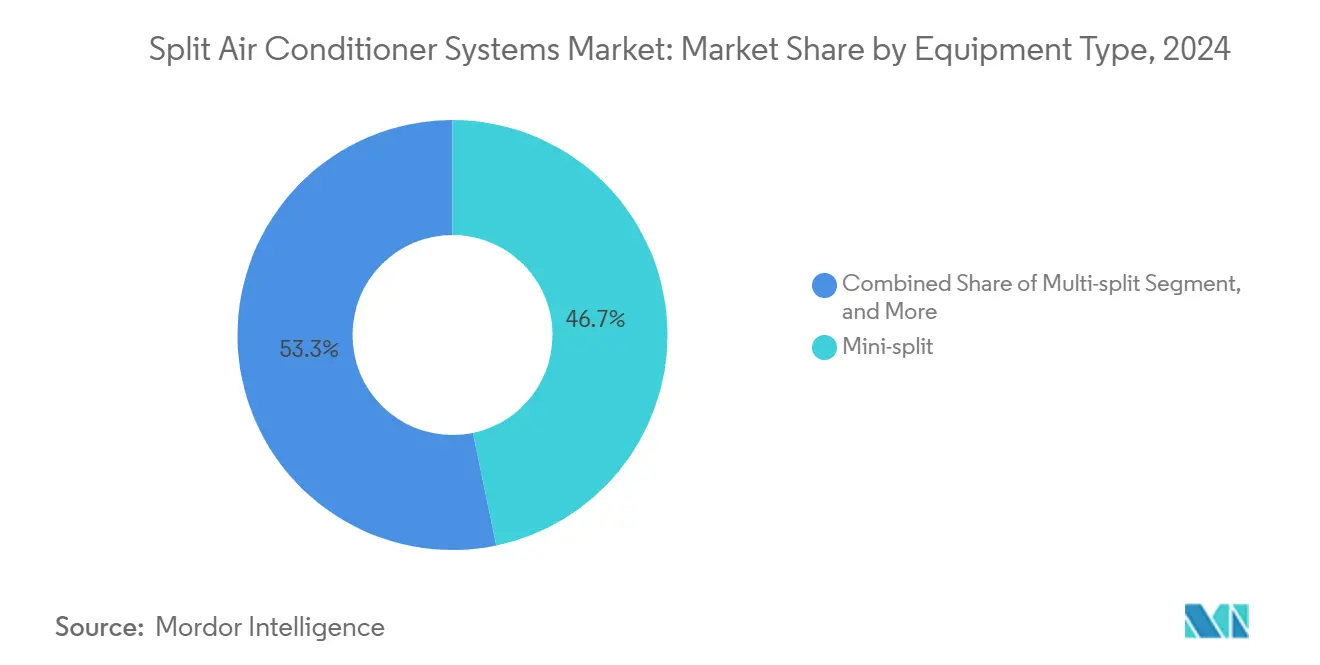
Note: Segment shares of all individual segments available upon report purchase
By Application: Commercial Retrofits Sustain Momentum
Residential units contributed 62.49% of 2024 revenue, confirming the consumer base that long defined the split air conditioner systems market size. Urban apartments still rely on ≤1-ton mini-splits to counter high-density heat gain, and replacement demand persists as early inverter models age past warranty. Retail financing and e-commerce logistics keep unit volumes high, making residential sales a scale arbiter for component sourcing.
Commercial upgrades, though smaller in volume, deliver the 6.87% CAGR that propels revenue expansion. Office landlords adopt VRF to match HVAC output with hybrid work occupancy, while hotels reinvest after pandemic-era downturns. Predictive maintenance suites add compliance reporting for indoor-air-quality mandates, offering another justification for capex. This service-led stickiness deepens the commercial shift of the split air conditioner systems market.
By Cooling Capacity: Large-Capacity Units Capture Design Trends
Units ≥36,000 BTU grew at 6.22% CAGR-faster than any other band-as open-plan offices and glass façades lift latent load and require sustained capacity. Larger compressors often exceed SEER 15 without complex variable-speed logic, easing code compliance. Hotels and retail anchors similarly trend upward in tonnage to maintain comfort against heat-island effects in dense city cores, reinforcing premium-priced segments.
Conversely, ≤12,000 BTU models, while holding 36.77% of 2024 revenue, now see decelerating growth because new apartments integrate better insulation and passive cooling. Manufacturers counter by bundling air purification, humidity control, and Wi-Fi monitoring to differentiate smaller units and protect margins within the split air conditioner systems market.
By Technology: Inverters Cement Leadership
Inverter models commanded 71.32% of 2024 revenue and are projected to add 6.93% annually, reflecting rebate influence and consumer preference for quieter, more precise cooling. Component cost curves have fallen enough that price gaps versus fixed-speed units close within two summers of electricity savings, satisfying both buyers and regulators. Suppliers integrate PCB diagnostics that upload fault codes to mobile apps, trimming service visits and boosting uptime.
Non-inverter systems hold niche roles where low initial price overrules lifecycle economics, such as rental properties with short tenures. Yet, impending regulatory bans on low-SEER equipment in the United States and Europe will gradually compress this niche, further consolidating revenue under inverters in the split air conditioner systems market.
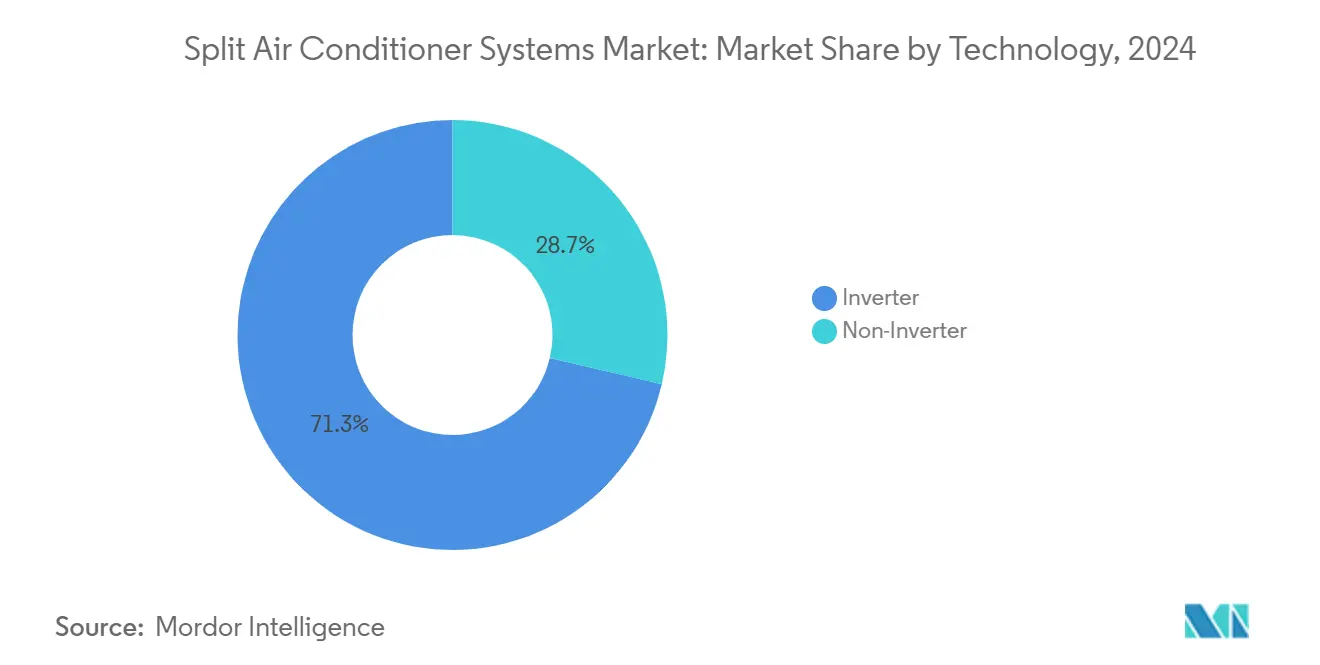
By Distribution Channel: Digital Disruption Gains Credibility
Multi-brand retail generated 69.86% of 2024 sales by providing immediate product availability, bundled installation, and local after-sales centers. Showrooms remain critical in emerging markets where first-time buyers prefer hands-on evaluation. Retailers are also upgrading in-store VRF demonstration labs targeted at small-business owners, tightening the link between residential and commercial clientele.
E-commerce advanced 6.46% a year, converting price-sensitive shoppers who value coupon promotions and sophisticated comparison tools. Marketplaces now curate certified installer networks, lowering perceived risk of online HVAC purchases. Direct-to-contractor platforms likewise scale in the commercial arena, letting facility managers obtain quotes and spare parts within unified dashboards. Together, these trends redraw the distribution economics across the split air conditioner systems market.
Geography Analysis
Asia-Pacific produced 41.53% of 2024 revenue, illustrating its role as both global factory and consumer nucleus for the split air conditioner systems market. China’s domestic demand absorbs half its mammoth output, while export orders move through consolidated supply chains that keep unit costs low. Japan and South Korea cultivate premium sub-segments built on technology leadership, securing healthy price realization even as volumes plateau. Meanwhile, India and ASEAN members elevate volume growth on the back of rising disposable income and government rebate schemes.
South America logged the fastest 5.64% CAGR, propelled by Brazil’s residential construction push and Argentina’s post-crisis rebound that frees consumer credit. Programs such as Brazil’s Minha Casa Minha Vida embed appliance loans within mortgage packages, effectively pre-selling cooling equipment to low-income households. Currency depreciation and import duties remain wild cards, yet regional assemblers lobby for tariff relief on compressor cores to localize more value.
North America and Europe, though mature, continue to upgrade stock with high-SEER inverters and IoT-ready VRF systems. Federal tax credits and EU F-Gas limits sharpen replacement urgency. New-build volume is modest, but deep-retrofit programs in offices, schools, and hospitals sustain growth. Arctic blast events and summer heat domes are normalizing mixed-mode heating and cooling demand, bolstering the all-season rationale for investment in the split air conditioner systems market.
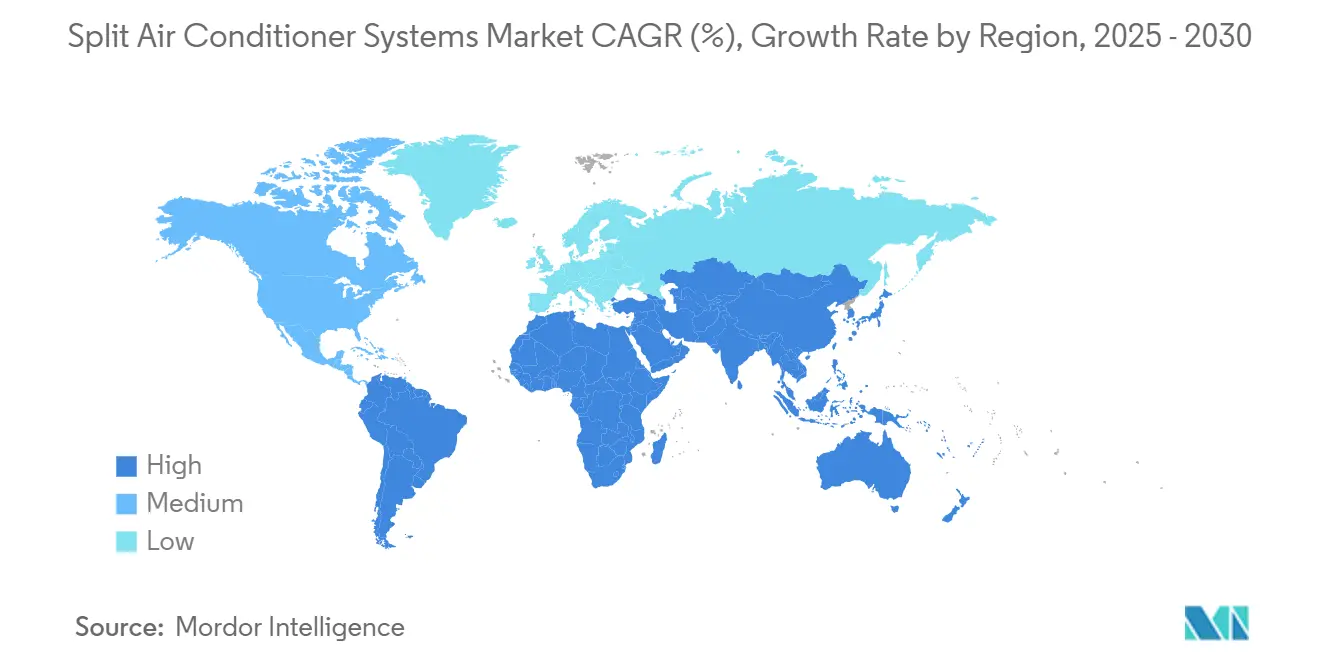
Competitive Landscape
Innovation and Sustainability Drive Future Success
The landscape remains moderately concentrated, with the top five brands controlling roughly 55% of 2024 revenue. Japanese incumbents-Daikin and Mitsubishi Electric-lead on compressor patents and reliability ratings, letting them price at a premium and dominate specifications in commercial tenders. Korean rivals Samsung and LG counter with AI-driven airflow algorithms that optimize comfort without cost penalties. Chinese leaders Midea and Gree leverage vertical supply chains to compress lead times and flood value segments, aggressively deploying e-commerce.
Strategic moves reflect a shift from hardware to service ecosystems. Daikin’s USD 850 million Texas expansion brings R-32 production in-house, shielding it from supply volatility and shortening delivery cycles. Samsung’s WindFree launch repositions airflow as a wellness proposition, securing differentiation in dense urban markets. Midea’s EU distributor acquisition delivers local after-sales capability and builds trust among commercial installers wary of offshore brands. LG’s R-290 introduction satisfies impending GWP caps in Europe, signaling readiness for global environmental regulation.
Start-ups focusing on software-only predictive maintenance emerge as collaborators rather than threats, licensing APIs to legacy OEMs hungry for digital competence. Meanwhile, supply chain localization and ESG reporting requirements create compliance costs that smaller assemblers struggle to meet, inching market power toward scale leaders. These dynamics collectively reinforce the moderate concentration profile of the split air conditioner systems market.
Split Air Conditioner Systems Industry Leaders
-
Daikin Industries, Ltd.
-
Mitsubishi Electric Corporation
-
Panasonic Holdings Corporation
-
Samsung Electronics Co., Ltd.
-
Carrier Global Corporation
- *Disclaimer: Major Players sorted in no particular order
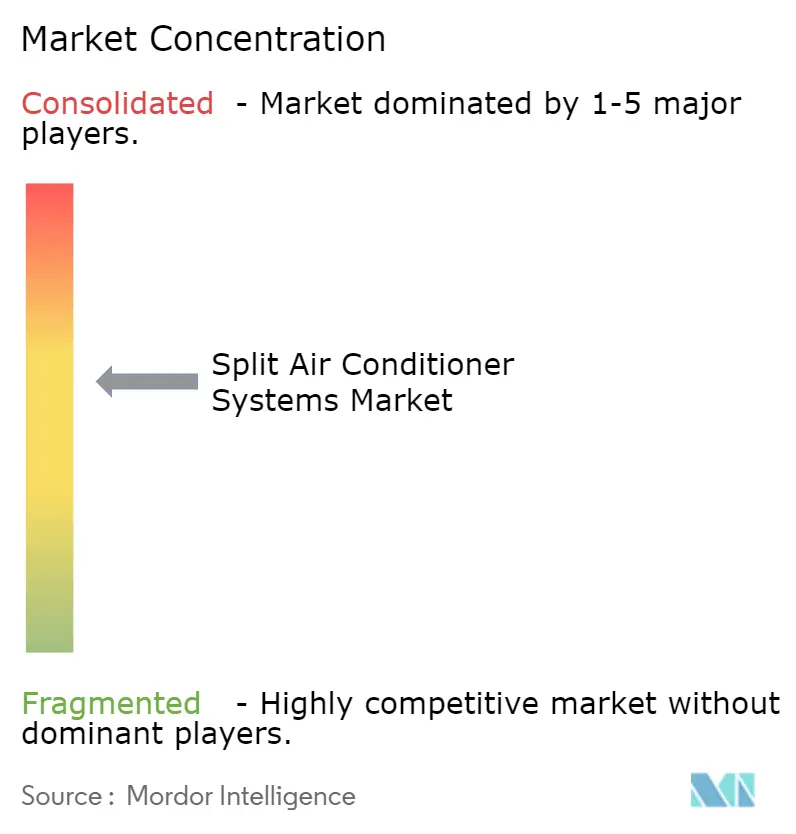
Recent Industry Developments
- October 2025: Daikin Industries allocated USD 1.2 billion to build next-generation R-32 refrigerant plants in Thailand and Malaysia. The investment will boost global supply capacity 40% by 2027 and includes heat-recovery systems that trim production energy use 25% to meet ASEAN environmental standards
- September 2025: Samsung Electronics extended its AI-driven WindFree Max platform to commercial VRF lines in South Korea, Japan, and select Southeast Asian countries. The machine-learning controls adapt to real-time occupancy and are expected to lower office energy costs 30-35%, with worldwide rollout scheduled for Q2 2026
- August 2025: LG Electronics finalized a USD 450 million purchase of Viessmann’s European commercial HVAC arm, gaining direct coverage in Germany, France, and Italy. The deal brings 15 service centers and 200 certified technicians, broadening LG’s VRF capabilities for cold-climate projects
- July 2025: Midea Group secured clearance from India’s Ministry of Environment for a USD 320 million factory in Gujarat. Designed for carbon-neutral operation by 2028, the plant will turn out 1.5 million residential and light-commercial split units annually for Indian and South Asian markets
Global Split Air Conditioner Systems Market Report Scope
A split system is an HVAC system that has both indoor and outdoor units that are connected with copper tubing. There are many different types of split systems, which can include either a heat pump or air conditioner installed outside your home, paired with either a gas furnace or a fan coil located inside your home.
The Split Air Conditioner Systems Market Report is Segmented by Equipment Type (Mini-split, Multi-split, and More), Application (Residential, Commercial), Cooling Capacity (12,001-24,000 BTU, 24,001-36,000 BTU, >36,000 BTU, and More), Technology (Inverter, Non-Inverter), Distribution Channel (Direct HVAC Contractors, Multi-Brand Retail, E-commerce), and Geography. Market Forecasts are Provided in Terms of Value (USD).
| Mini-split |
| Multi-split |
| Variable Refrigerant Flow (VRF) |
| Ductless Packaged and Other Equipment Types |
| Residential |
| Commercial |
| Less than or equal to 12,000 (1-Ton) BTU |
| 12,001–24,000 (1-2-Ton) BTU |
| 24,001–36,000 (2-3-Ton) BTU |
| Greater than 36,000 (≥3-Ton) BTU |
| Inverter |
| Non-Inverter |
| Direct HVAC Contractors / OEM Dealers |
| Multi-Brand Retail Stores |
| E-commerce |
| North America | United States | |
| Canada | ||
| Mexico | ||
| Europe | Germany | |
| United Kingdom | ||
| France | ||
| Russia | ||
| Rest of Europe | ||
| Asia-Pacific | China | |
| Japan | ||
| India | ||
| South Korea | ||
| Australia | ||
| Rest of Asia-Pacific | ||
| Middle East and Africa | Middle East | Saudi Arabia |
| United Arab Emirates | ||
| Rest of Middle East | ||
| Africa | South Africa | |
| Egypt | ||
| Rest of Africa | ||
| South America | Brazil | |
| Argentina | ||
| Rest of South America | ||
| By Equipment Type | Mini-split | ||
| Multi-split | |||
| Variable Refrigerant Flow (VRF) | |||
| Ductless Packaged and Other Equipment Types | |||
| By Application | Residential | ||
| Commercial | |||
| By Cooling Capacity (BTU/hr) | Less than or equal to 12,000 (1-Ton) BTU | ||
| 12,001–24,000 (1-2-Ton) BTU | |||
| 24,001–36,000 (2-3-Ton) BTU | |||
| Greater than 36,000 (≥3-Ton) BTU | |||
| By Technology | Inverter | ||
| Non-Inverter | |||
| By Distribution Channel | Direct HVAC Contractors / OEM Dealers | ||
| Multi-Brand Retail Stores | |||
| E-commerce | |||
| By Geography | North America | United States | |
| Canada | |||
| Mexico | |||
| Europe | Germany | ||
| United Kingdom | |||
| France | |||
| Russia | |||
| Rest of Europe | |||
| Asia-Pacific | China | ||
| Japan | |||
| India | |||
| South Korea | |||
| Australia | |||
| Rest of Asia-Pacific | |||
| Middle East and Africa | Middle East | Saudi Arabia | |
| United Arab Emirates | |||
| Rest of Middle East | |||
| Africa | South Africa | ||
| Egypt | |||
| Rest of Africa | |||
| South America | Brazil | ||
| Argentina | |||
| Rest of South America | |||
Key Questions Answered in the Report
What is the projected value of the split air conditioner systems market by 2030?
The market is forecast to reach USD 162.73 billion by 2030, up from USD 127.62 billion in 2025.
Which technology segment is growing fastest?
Inverter models are expanding at a 6.93% CAGR thanks to global efficiency regulations and rebate programs.
Why are VRF systems gaining share in commercial buildings?
VRF units offer simultaneous heating and cooling across zones, align with hybrid work occupancy, and integrate easily with predictive-maintenance software.
Which region shows the highest growth rate?
South America leads with a 5.64% CAGR, fueled by urbanization and appliance financing initiatives in Brazil and Argentina.
How is e-commerce affecting HVAC distribution?
Online platforms deliver 6.46% annual growth by bundling installation services and transparent pricing, challenging brick-and-mortar dominance.
What is the main restraint facing manufacturers?
High installation and maintenance costs, especially the premium for certified VRF technicians, slow adoption in price-sensitive markets.
Page last updated on:
